Comprehensive Financial Analysis: Ratios, Cash Flow, Investments
VerifiedAdded on 2023/06/04
|19
|3797
|192
Report
AI Summary
This report provides a comprehensive financial analysis, encompassing the calculation and interpretation of key financial ratios such as gross profit margin, asset usage, current ratio, acid test ratio, inventory holding period, and debt-to-equity ratio for the years 2018 and 2019. It emphasizes the significance of considering the users of financial statements in the analysis. Furthermore, the report includes a monthly cash flow forecast, assesses the opening financial position, and identifies additional expenses for business owners to consider. A break-even point analysis is conducted for 2019 and 2020, alongside a critical evaluation of Jessica's developed strategy. Finally, the report calculates and evaluates the payback period, net present value, and average rate of return for prospective investment projects, determining the most efficient investment option and discussing various investment appraisal approaches. Desklib offers a wealth of similar documents and study resources for students.

Introduction to
Finance
Finance
Paraphrase This Document
Need a fresh take? Get an instant paraphrase of this document with our AI Paraphraser
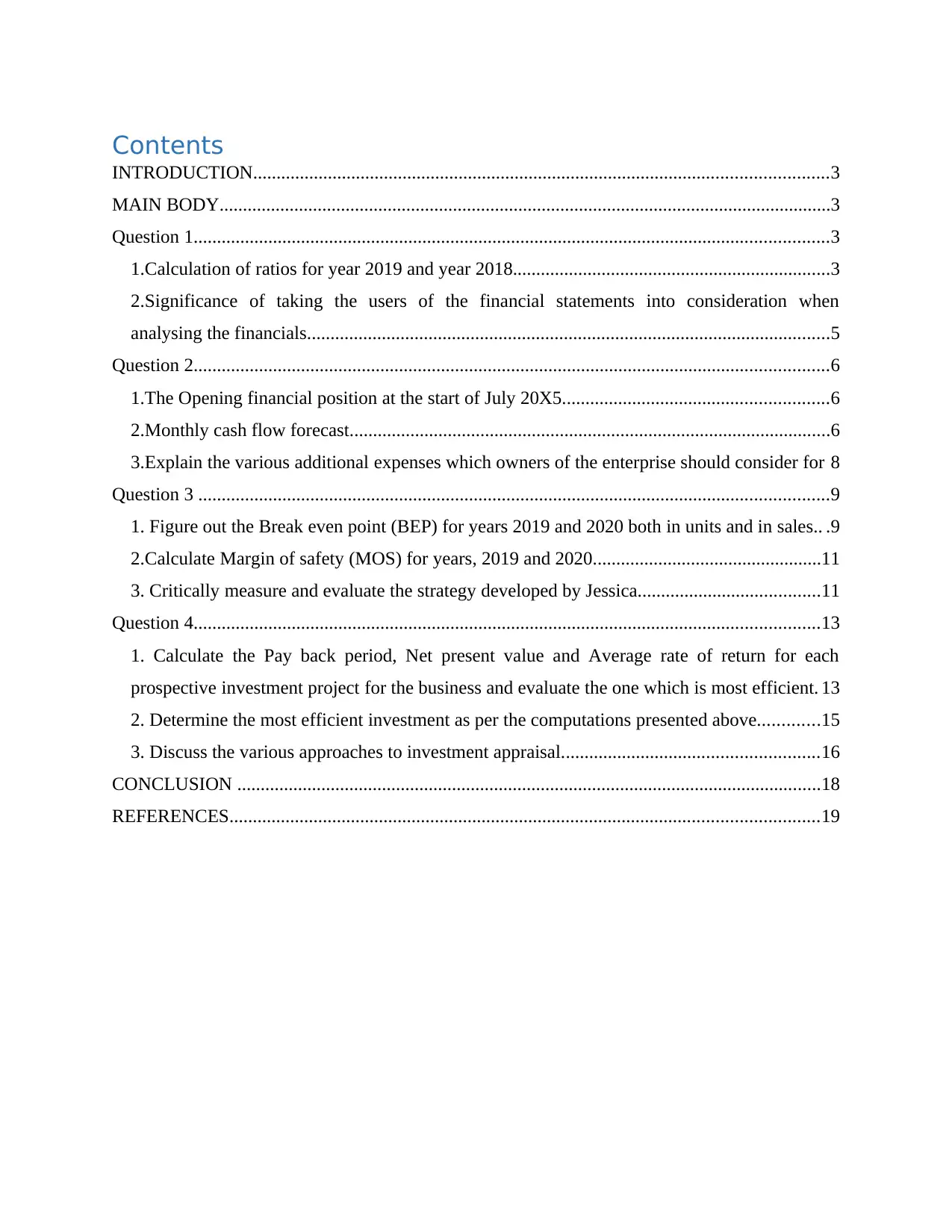
Contents
INTRODUCTION...........................................................................................................................3
MAIN BODY...................................................................................................................................3
Question 1........................................................................................................................................3
1.Calculation of ratios for year 2019 and year 2018....................................................................3
2.Significance of taking the users of the financial statements into consideration when
analysing the financials................................................................................................................5
Question 2........................................................................................................................................6
1.The Opening financial position at the start of July 20X5.........................................................6
2.Monthly cash flow forecast.......................................................................................................6
3.Explain the various additional expenses which owners of the enterprise should consider for 8
Question 3 .......................................................................................................................................9
1. Figure out the Break even point (BEP) for years 2019 and 2020 both in units and in sales.. .9
2.Calculate Margin of safety (MOS) for years, 2019 and 2020.................................................11
3. Critically measure and evaluate the strategy developed by Jessica.......................................11
Question 4......................................................................................................................................13
1. Calculate the Pay back period, Net present value and Average rate of return for each
prospective investment project for the business and evaluate the one which is most efficient. 13
2. Determine the most efficient investment as per the computations presented above.............15
3. Discuss the various approaches to investment appraisal.......................................................16
CONCLUSION .............................................................................................................................18
REFERENCES..............................................................................................................................19
INTRODUCTION...........................................................................................................................3
MAIN BODY...................................................................................................................................3
Question 1........................................................................................................................................3
1.Calculation of ratios for year 2019 and year 2018....................................................................3
2.Significance of taking the users of the financial statements into consideration when
analysing the financials................................................................................................................5
Question 2........................................................................................................................................6
1.The Opening financial position at the start of July 20X5.........................................................6
2.Monthly cash flow forecast.......................................................................................................6
3.Explain the various additional expenses which owners of the enterprise should consider for 8
Question 3 .......................................................................................................................................9
1. Figure out the Break even point (BEP) for years 2019 and 2020 both in units and in sales.. .9
2.Calculate Margin of safety (MOS) for years, 2019 and 2020.................................................11
3. Critically measure and evaluate the strategy developed by Jessica.......................................11
Question 4......................................................................................................................................13
1. Calculate the Pay back period, Net present value and Average rate of return for each
prospective investment project for the business and evaluate the one which is most efficient. 13
2. Determine the most efficient investment as per the computations presented above.............15
3. Discuss the various approaches to investment appraisal.......................................................16
CONCLUSION .............................................................................................................................18
REFERENCES..............................................................................................................................19
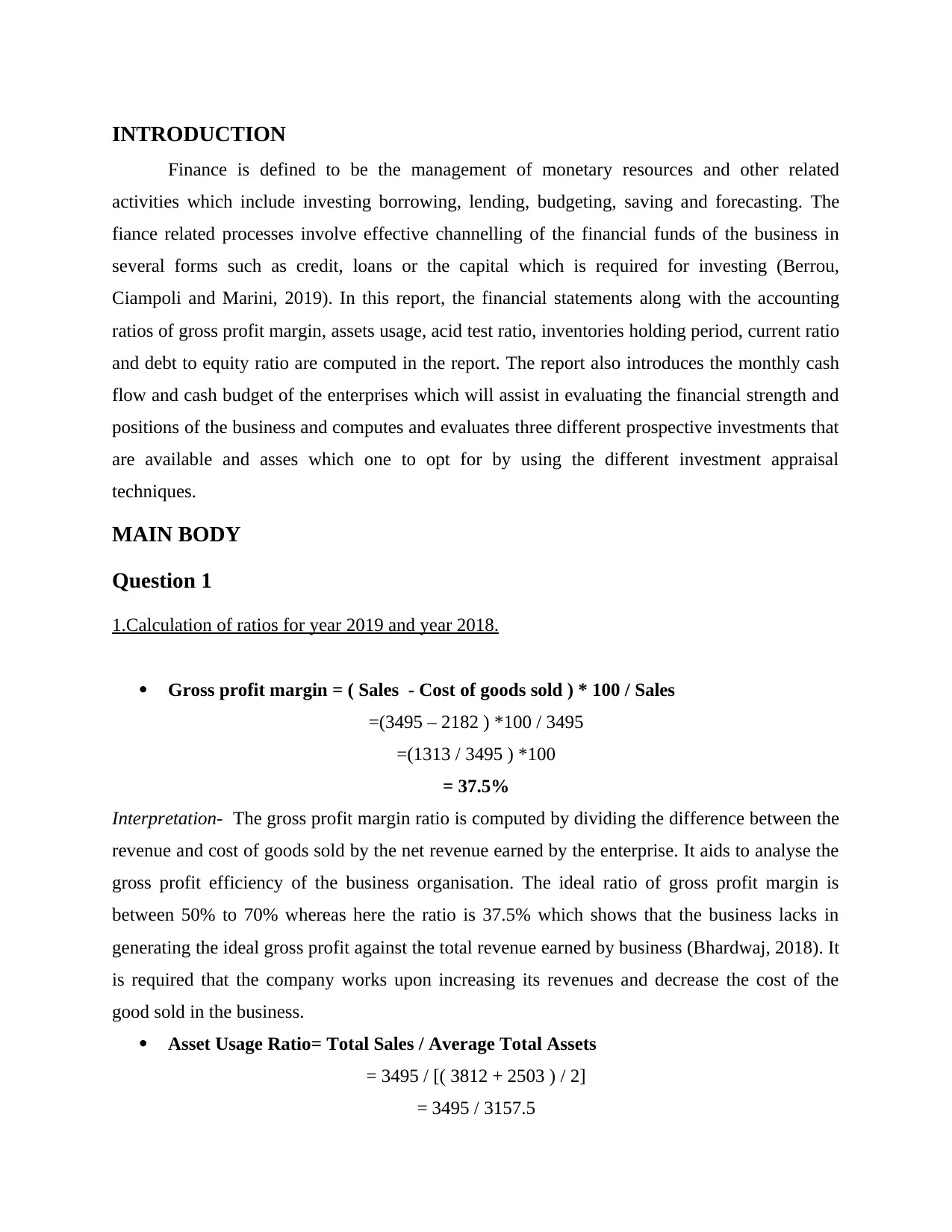
INTRODUCTION
Finance is defined to be the management of monetary resources and other related
activities which include investing borrowing, lending, budgeting, saving and forecasting. The
fiance related processes involve effective channelling of the financial funds of the business in
several forms such as credit, loans or the capital which is required for investing (Berrou,
Ciampoli and Marini, 2019). In this report, the financial statements along with the accounting
ratios of gross profit margin, assets usage, acid test ratio, inventories holding period, current ratio
and debt to equity ratio are computed in the report. The report also introduces the monthly cash
flow and cash budget of the enterprises which will assist in evaluating the financial strength and
positions of the business and computes and evaluates three different prospective investments that
are available and asses which one to opt for by using the different investment appraisal
techniques.
MAIN BODY
Question 1
1.Calculation of ratios for year 2019 and year 2018.
Gross profit margin = ( Sales - Cost of goods sold ) * 100 / Sales
=(3495 – 2182 ) *100 / 3495
=(1313 / 3495 ) *100
= 37.5%
Interpretation- The gross profit margin ratio is computed by dividing the difference between the
revenue and cost of goods sold by the net revenue earned by the enterprise. It aids to analyse the
gross profit efficiency of the business organisation. The ideal ratio of gross profit margin is
between 50% to 70% whereas here the ratio is 37.5% which shows that the business lacks in
generating the ideal gross profit against the total revenue earned by business (Bhardwaj, 2018). It
is required that the company works upon increasing its revenues and decrease the cost of the
good sold in the business.
Asset Usage Ratio= Total Sales / Average Total Assets
= 3495 / [( 3812 + 2503 ) / 2]
= 3495 / 3157.5
Finance is defined to be the management of monetary resources and other related
activities which include investing borrowing, lending, budgeting, saving and forecasting. The
fiance related processes involve effective channelling of the financial funds of the business in
several forms such as credit, loans or the capital which is required for investing (Berrou,
Ciampoli and Marini, 2019). In this report, the financial statements along with the accounting
ratios of gross profit margin, assets usage, acid test ratio, inventories holding period, current ratio
and debt to equity ratio are computed in the report. The report also introduces the monthly cash
flow and cash budget of the enterprises which will assist in evaluating the financial strength and
positions of the business and computes and evaluates three different prospective investments that
are available and asses which one to opt for by using the different investment appraisal
techniques.
MAIN BODY
Question 1
1.Calculation of ratios for year 2019 and year 2018.
Gross profit margin = ( Sales - Cost of goods sold ) * 100 / Sales
=(3495 – 2182 ) *100 / 3495
=(1313 / 3495 ) *100
= 37.5%
Interpretation- The gross profit margin ratio is computed by dividing the difference between the
revenue and cost of goods sold by the net revenue earned by the enterprise. It aids to analyse the
gross profit efficiency of the business organisation. The ideal ratio of gross profit margin is
between 50% to 70% whereas here the ratio is 37.5% which shows that the business lacks in
generating the ideal gross profit against the total revenue earned by business (Bhardwaj, 2018). It
is required that the company works upon increasing its revenues and decrease the cost of the
good sold in the business.
Asset Usage Ratio= Total Sales / Average Total Assets
= 3495 / [( 3812 + 2503 ) / 2]
= 3495 / 3157.5
⊘ This is a preview!⊘
Do you want full access?
Subscribe today to unlock all pages.

Trusted by 1+ million students worldwide
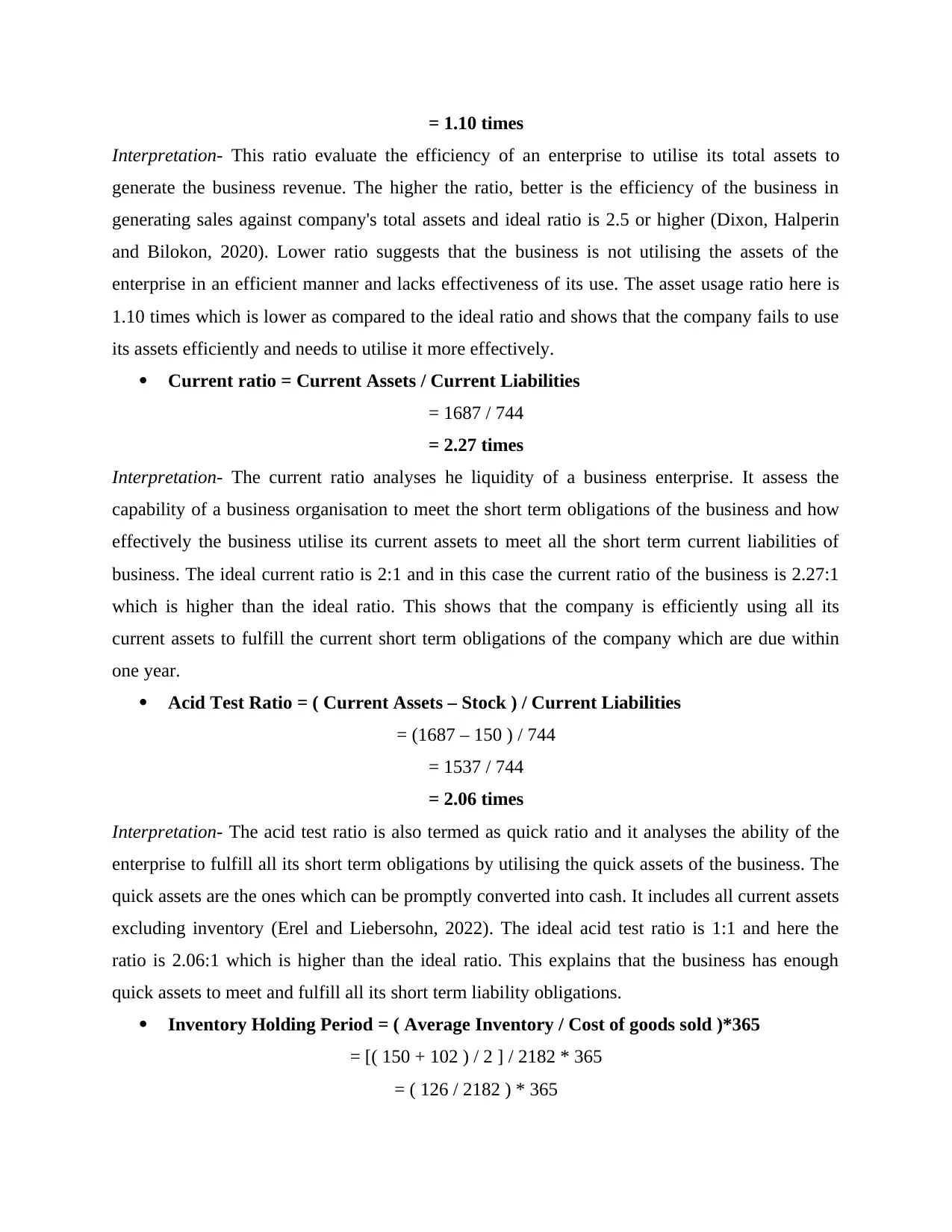
= 1.10 times
Interpretation- This ratio evaluate the efficiency of an enterprise to utilise its total assets to
generate the business revenue. The higher the ratio, better is the efficiency of the business in
generating sales against company's total assets and ideal ratio is 2.5 or higher (Dixon, Halperin
and Bilokon, 2020). Lower ratio suggests that the business is not utilising the assets of the
enterprise in an efficient manner and lacks effectiveness of its use. The asset usage ratio here is
1.10 times which is lower as compared to the ideal ratio and shows that the company fails to use
its assets efficiently and needs to utilise it more effectively.
Current ratio = Current Assets / Current Liabilities
= 1687 / 744
= 2.27 times
Interpretation- The current ratio analyses he liquidity of a business enterprise. It assess the
capability of a business organisation to meet the short term obligations of the business and how
effectively the business utilise its current assets to meet all the short term current liabilities of
business. The ideal current ratio is 2:1 and in this case the current ratio of the business is 2.27:1
which is higher than the ideal ratio. This shows that the company is efficiently using all its
current assets to fulfill the current short term obligations of the company which are due within
one year.
Acid Test Ratio = ( Current Assets – Stock ) / Current Liabilities
= (1687 – 150 ) / 744
= 1537 / 744
= 2.06 times
Interpretation- The acid test ratio is also termed as quick ratio and it analyses the ability of the
enterprise to fulfill all its short term obligations by utilising the quick assets of the business. The
quick assets are the ones which can be promptly converted into cash. It includes all current assets
excluding inventory (Erel and Liebersohn, 2022). The ideal acid test ratio is 1:1 and here the
ratio is 2.06:1 which is higher than the ideal ratio. This explains that the business has enough
quick assets to meet and fulfill all its short term liability obligations.
Inventory Holding Period = ( Average Inventory / Cost of goods sold )*365
= [( 150 + 102 ) / 2 ] / 2182 * 365
= ( 126 / 2182 ) * 365
Interpretation- This ratio evaluate the efficiency of an enterprise to utilise its total assets to
generate the business revenue. The higher the ratio, better is the efficiency of the business in
generating sales against company's total assets and ideal ratio is 2.5 or higher (Dixon, Halperin
and Bilokon, 2020). Lower ratio suggests that the business is not utilising the assets of the
enterprise in an efficient manner and lacks effectiveness of its use. The asset usage ratio here is
1.10 times which is lower as compared to the ideal ratio and shows that the company fails to use
its assets efficiently and needs to utilise it more effectively.
Current ratio = Current Assets / Current Liabilities
= 1687 / 744
= 2.27 times
Interpretation- The current ratio analyses he liquidity of a business enterprise. It assess the
capability of a business organisation to meet the short term obligations of the business and how
effectively the business utilise its current assets to meet all the short term current liabilities of
business. The ideal current ratio is 2:1 and in this case the current ratio of the business is 2.27:1
which is higher than the ideal ratio. This shows that the company is efficiently using all its
current assets to fulfill the current short term obligations of the company which are due within
one year.
Acid Test Ratio = ( Current Assets – Stock ) / Current Liabilities
= (1687 – 150 ) / 744
= 1537 / 744
= 2.06 times
Interpretation- The acid test ratio is also termed as quick ratio and it analyses the ability of the
enterprise to fulfill all its short term obligations by utilising the quick assets of the business. The
quick assets are the ones which can be promptly converted into cash. It includes all current assets
excluding inventory (Erel and Liebersohn, 2022). The ideal acid test ratio is 1:1 and here the
ratio is 2.06:1 which is higher than the ideal ratio. This explains that the business has enough
quick assets to meet and fulfill all its short term liability obligations.
Inventory Holding Period = ( Average Inventory / Cost of goods sold )*365
= [( 150 + 102 ) / 2 ] / 2182 * 365
= ( 126 / 2182 ) * 365
Paraphrase This Document
Need a fresh take? Get an instant paraphrase of this document with our AI Paraphraser
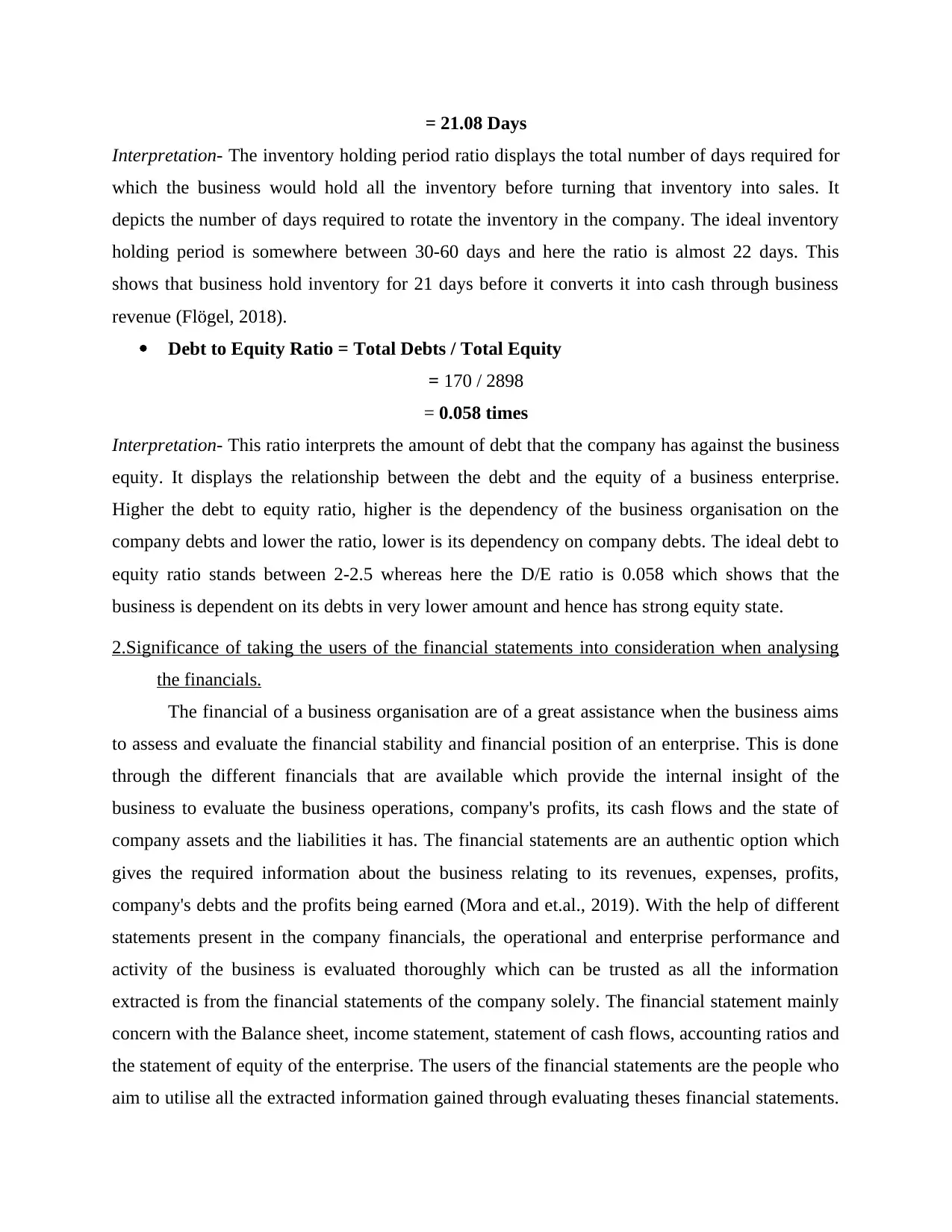
= 21.08 Days
Interpretation- The inventory holding period ratio displays the total number of days required for
which the business would hold all the inventory before turning that inventory into sales. It
depicts the number of days required to rotate the inventory in the company. The ideal inventory
holding period is somewhere between 30-60 days and here the ratio is almost 22 days. This
shows that business hold inventory for 21 days before it converts it into cash through business
revenue (Flögel, 2018).
Debt to Equity Ratio = Total Debts / Total Equity
= 170 / 2898
= 0.058 times
Interpretation- This ratio interprets the amount of debt that the company has against the business
equity. It displays the relationship between the debt and the equity of a business enterprise.
Higher the debt to equity ratio, higher is the dependency of the business organisation on the
company debts and lower the ratio, lower is its dependency on company debts. The ideal debt to
equity ratio stands between 2-2.5 whereas here the D/E ratio is 0.058 which shows that the
business is dependent on its debts in very lower amount and hence has strong equity state.
2.Significance of taking the users of the financial statements into consideration when analysing
the financials.
The financial of a business organisation are of a great assistance when the business aims
to assess and evaluate the financial stability and financial position of an enterprise. This is done
through the different financials that are available which provide the internal insight of the
business to evaluate the business operations, company's profits, its cash flows and the state of
company assets and the liabilities it has. The financial statements are an authentic option which
gives the required information about the business relating to its revenues, expenses, profits,
company's debts and the profits being earned (Mora and et.al., 2019). With the help of different
statements present in the company financials, the operational and enterprise performance and
activity of the business is evaluated thoroughly which can be trusted as all the information
extracted is from the financial statements of the company solely. The financial statement mainly
concern with the Balance sheet, income statement, statement of cash flows, accounting ratios and
the statement of equity of the enterprise. The users of the financial statements are the people who
aim to utilise all the extracted information gained through evaluating theses financial statements.
Interpretation- The inventory holding period ratio displays the total number of days required for
which the business would hold all the inventory before turning that inventory into sales. It
depicts the number of days required to rotate the inventory in the company. The ideal inventory
holding period is somewhere between 30-60 days and here the ratio is almost 22 days. This
shows that business hold inventory for 21 days before it converts it into cash through business
revenue (Flögel, 2018).
Debt to Equity Ratio = Total Debts / Total Equity
= 170 / 2898
= 0.058 times
Interpretation- This ratio interprets the amount of debt that the company has against the business
equity. It displays the relationship between the debt and the equity of a business enterprise.
Higher the debt to equity ratio, higher is the dependency of the business organisation on the
company debts and lower the ratio, lower is its dependency on company debts. The ideal debt to
equity ratio stands between 2-2.5 whereas here the D/E ratio is 0.058 which shows that the
business is dependent on its debts in very lower amount and hence has strong equity state.
2.Significance of taking the users of the financial statements into consideration when analysing
the financials.
The financial of a business organisation are of a great assistance when the business aims
to assess and evaluate the financial stability and financial position of an enterprise. This is done
through the different financials that are available which provide the internal insight of the
business to evaluate the business operations, company's profits, its cash flows and the state of
company assets and the liabilities it has. The financial statements are an authentic option which
gives the required information about the business relating to its revenues, expenses, profits,
company's debts and the profits being earned (Mora and et.al., 2019). With the help of different
statements present in the company financials, the operational and enterprise performance and
activity of the business is evaluated thoroughly which can be trusted as all the information
extracted is from the financial statements of the company solely. The financial statement mainly
concern with the Balance sheet, income statement, statement of cash flows, accounting ratios and
the statement of equity of the enterprise. The users of the financial statements are the people who
aim to utilise all the extracted information gained through evaluating theses financial statements.
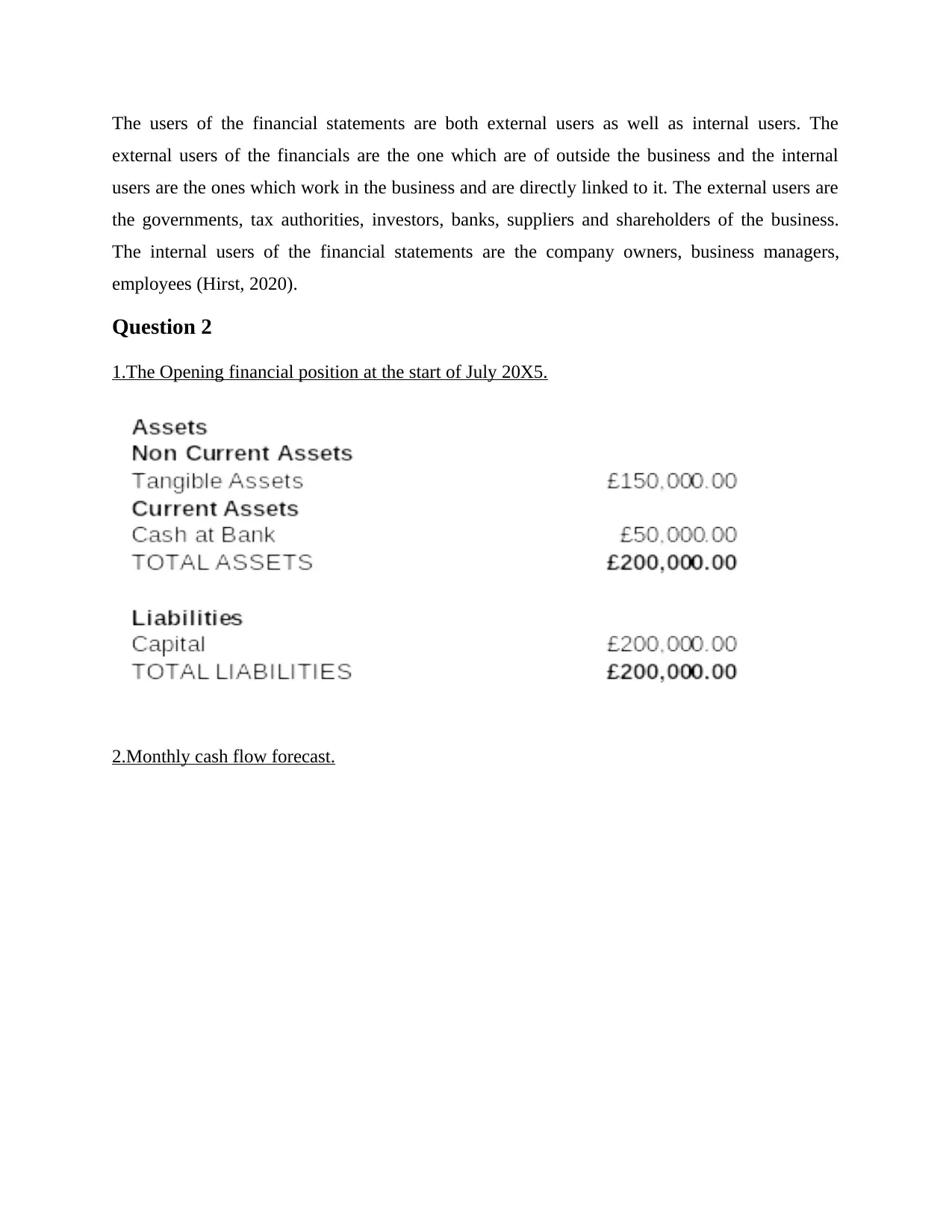
The users of the financial statements are both external users as well as internal users. The
external users of the financials are the one which are of outside the business and the internal
users are the ones which work in the business and are directly linked to it. The external users are
the governments, tax authorities, investors, banks, suppliers and shareholders of the business.
The internal users of the financial statements are the company owners, business managers,
employees (Hirst, 2020).
Question 2
1.The Opening financial position at the start of July 20X5.
2.Monthly cash flow forecast.
external users of the financials are the one which are of outside the business and the internal
users are the ones which work in the business and are directly linked to it. The external users are
the governments, tax authorities, investors, banks, suppliers and shareholders of the business.
The internal users of the financial statements are the company owners, business managers,
employees (Hirst, 2020).
Question 2
1.The Opening financial position at the start of July 20X5.
2.Monthly cash flow forecast.
⊘ This is a preview!⊘
Do you want full access?
Subscribe today to unlock all pages.

Trusted by 1+ million students worldwide
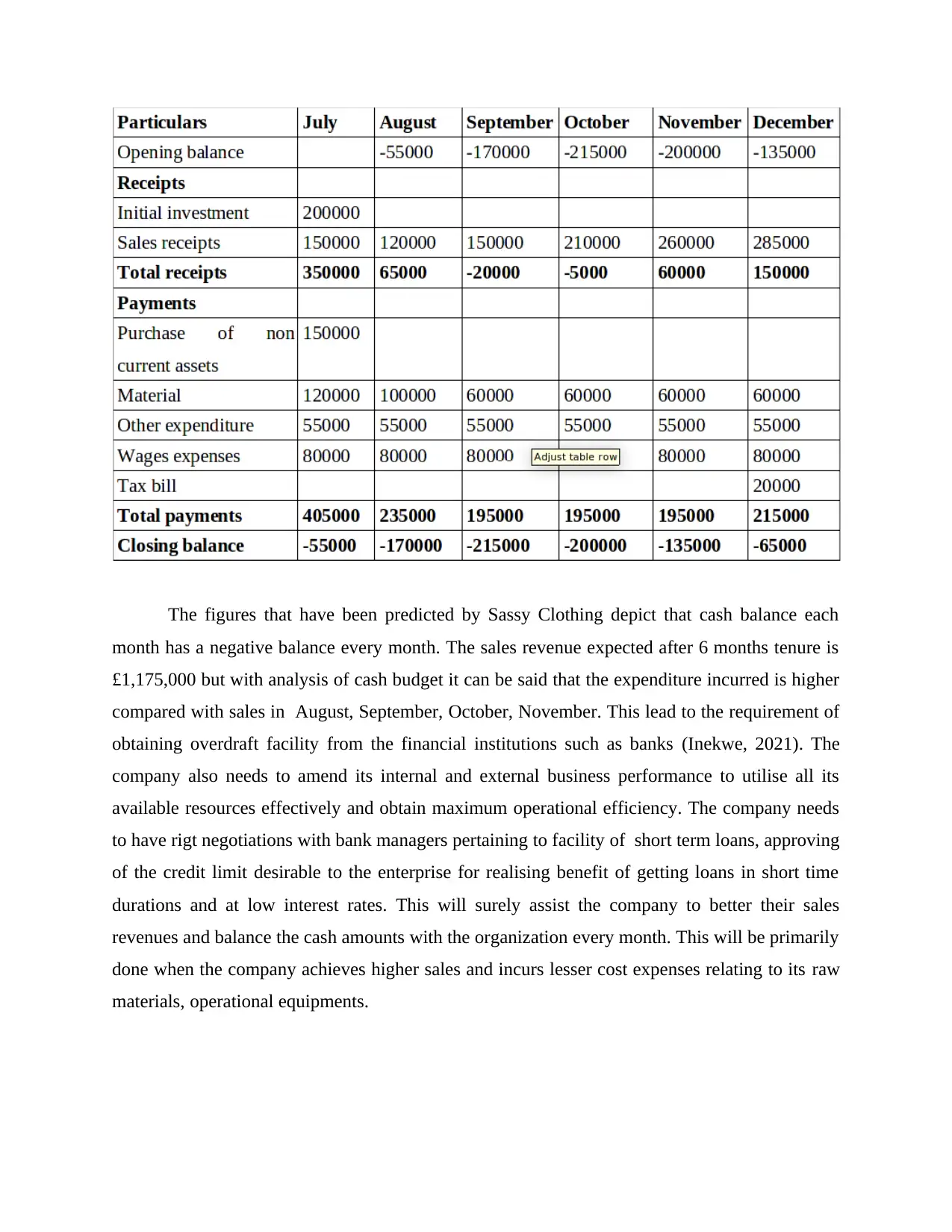
The figures that have been predicted by Sassy Clothing depict that cash balance each
month has a negative balance every month. The sales revenue expected after 6 months tenure is
£1,175,000 but with analysis of cash budget it can be said that the expenditure incurred is higher
compared with sales in August, September, October, November. This lead to the requirement of
obtaining overdraft facility from the financial institutions such as banks (Inekwe, 2021). The
company also needs to amend its internal and external business performance to utilise all its
available resources effectively and obtain maximum operational efficiency. The company needs
to have rigt negotiations with bank managers pertaining to facility of short term loans, approving
of the credit limit desirable to the enterprise for realising benefit of getting loans in short time
durations and at low interest rates. This will surely assist the company to better their sales
revenues and balance the cash amounts with the organization every month. This will be primarily
done when the company achieves higher sales and incurs lesser cost expenses relating to its raw
materials, operational equipments.
month has a negative balance every month. The sales revenue expected after 6 months tenure is
£1,175,000 but with analysis of cash budget it can be said that the expenditure incurred is higher
compared with sales in August, September, October, November. This lead to the requirement of
obtaining overdraft facility from the financial institutions such as banks (Inekwe, 2021). The
company also needs to amend its internal and external business performance to utilise all its
available resources effectively and obtain maximum operational efficiency. The company needs
to have rigt negotiations with bank managers pertaining to facility of short term loans, approving
of the credit limit desirable to the enterprise for realising benefit of getting loans in short time
durations and at low interest rates. This will surely assist the company to better their sales
revenues and balance the cash amounts with the organization every month. This will be primarily
done when the company achieves higher sales and incurs lesser cost expenses relating to its raw
materials, operational equipments.
Paraphrase This Document
Need a fresh take? Get an instant paraphrase of this document with our AI Paraphraser
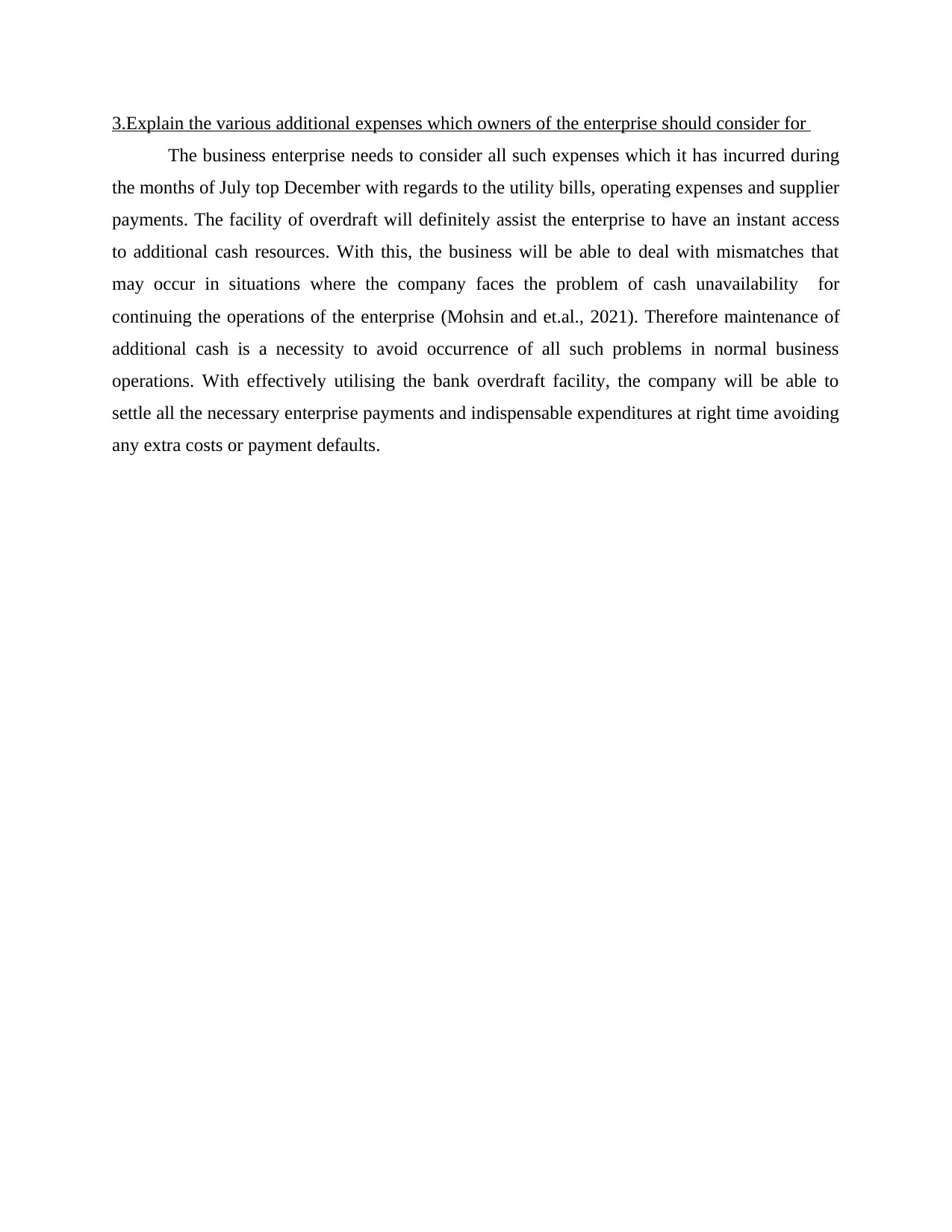
3.Explain the various additional expenses which owners of the enterprise should consider for
The business enterprise needs to consider all such expenses which it has incurred during
the months of July top December with regards to the utility bills, operating expenses and supplier
payments. The facility of overdraft will definitely assist the enterprise to have an instant access
to additional cash resources. With this, the business will be able to deal with mismatches that
may occur in situations where the company faces the problem of cash unavailability for
continuing the operations of the enterprise (Mohsin and et.al., 2021). Therefore maintenance of
additional cash is a necessity to avoid occurrence of all such problems in normal business
operations. With effectively utilising the bank overdraft facility, the company will be able to
settle all the necessary enterprise payments and indispensable expenditures at right time avoiding
any extra costs or payment defaults.
The business enterprise needs to consider all such expenses which it has incurred during
the months of July top December with regards to the utility bills, operating expenses and supplier
payments. The facility of overdraft will definitely assist the enterprise to have an instant access
to additional cash resources. With this, the business will be able to deal with mismatches that
may occur in situations where the company faces the problem of cash unavailability for
continuing the operations of the enterprise (Mohsin and et.al., 2021). Therefore maintenance of
additional cash is a necessity to avoid occurrence of all such problems in normal business
operations. With effectively utilising the bank overdraft facility, the company will be able to
settle all the necessary enterprise payments and indispensable expenditures at right time avoiding
any extra costs or payment defaults.
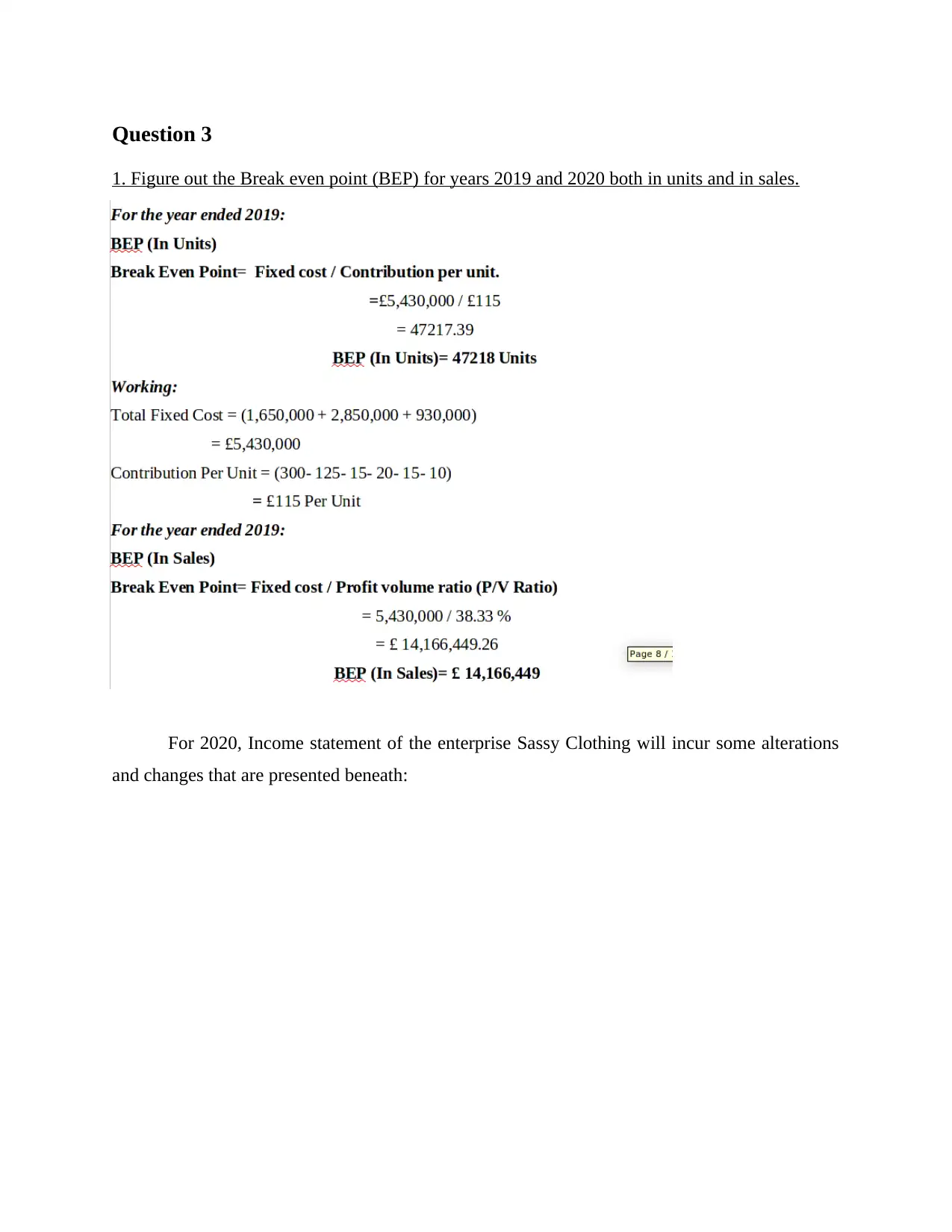
Question 3
1. Figure out the Break even point (BEP) for years 2019 and 2020 both in units and in sales.
For 2020, Income statement of the enterprise Sassy Clothing will incur some alterations
and changes that are presented beneath:
1. Figure out the Break even point (BEP) for years 2019 and 2020 both in units and in sales.
For 2020, Income statement of the enterprise Sassy Clothing will incur some alterations
and changes that are presented beneath:
⊘ This is a preview!⊘
Do you want full access?
Subscribe today to unlock all pages.

Trusted by 1+ million students worldwide
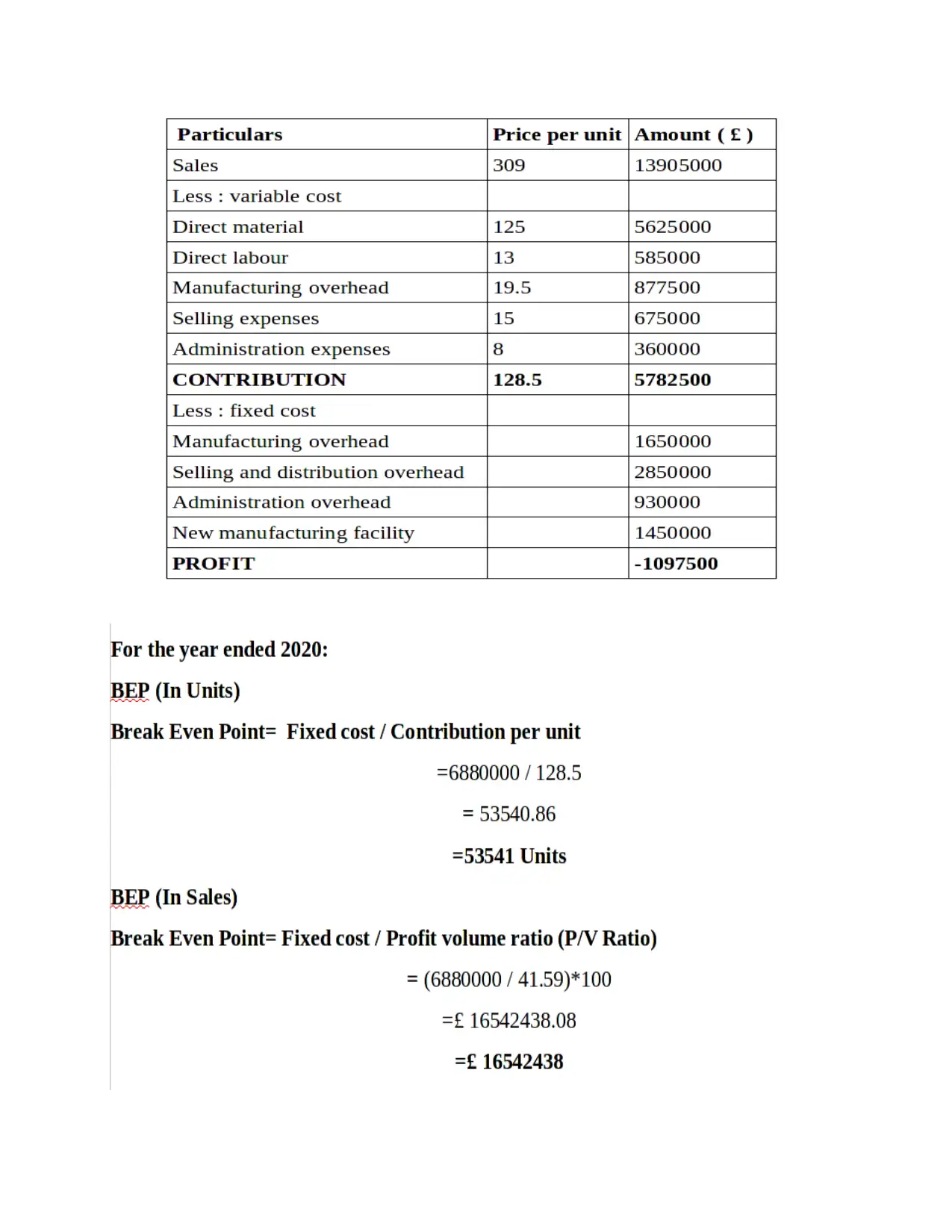
Paraphrase This Document
Need a fresh take? Get an instant paraphrase of this document with our AI Paraphraser
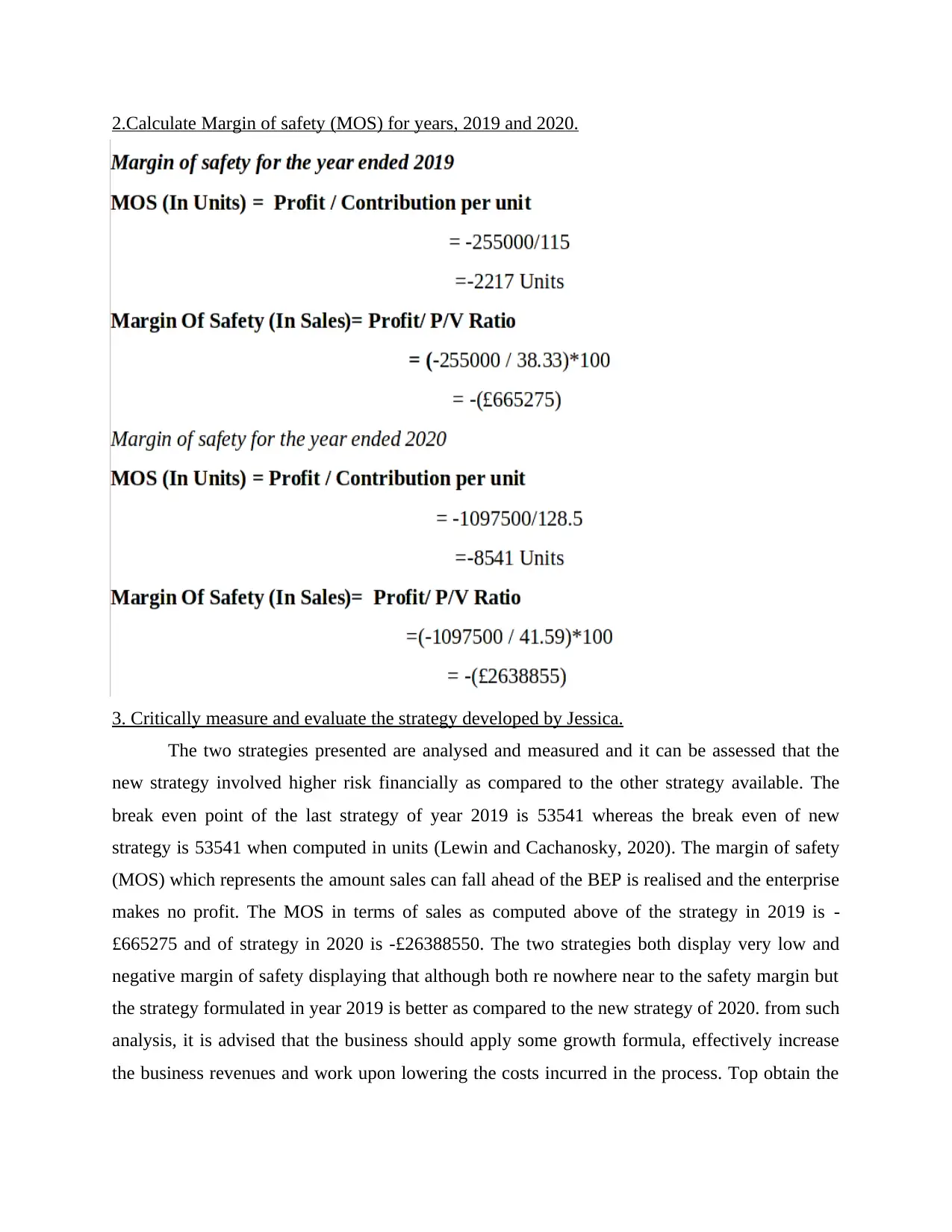
2.Calculate Margin of safety (MOS) for years, 2019 and 2020.
3. Critically measure and evaluate the strategy developed by Jessica.
The two strategies presented are analysed and measured and it can be assessed that the
new strategy involved higher risk financially as compared to the other strategy available. The
break even point of the last strategy of year 2019 is 53541 whereas the break even of new
strategy is 53541 when computed in units (Lewin and Cachanosky, 2020). The margin of safety
(MOS) which represents the amount sales can fall ahead of the BEP is realised and the enterprise
makes no profit. The MOS in terms of sales as computed above of the strategy in 2019 is -
£665275 and of strategy in 2020 is -£26388550. The two strategies both display very low and
negative margin of safety displaying that although both re nowhere near to the safety margin but
the strategy formulated in year 2019 is better as compared to the new strategy of 2020. from such
analysis, it is advised that the business should apply some growth formula, effectively increase
the business revenues and work upon lowering the costs incurred in the process. Top obtain the
3. Critically measure and evaluate the strategy developed by Jessica.
The two strategies presented are analysed and measured and it can be assessed that the
new strategy involved higher risk financially as compared to the other strategy available. The
break even point of the last strategy of year 2019 is 53541 whereas the break even of new
strategy is 53541 when computed in units (Lewin and Cachanosky, 2020). The margin of safety
(MOS) which represents the amount sales can fall ahead of the BEP is realised and the enterprise
makes no profit. The MOS in terms of sales as computed above of the strategy in 2019 is -
£665275 and of strategy in 2020 is -£26388550. The two strategies both display very low and
negative margin of safety displaying that although both re nowhere near to the safety margin but
the strategy formulated in year 2019 is better as compared to the new strategy of 2020. from such
analysis, it is advised that the business should apply some growth formula, effectively increase
the business revenues and work upon lowering the costs incurred in the process. Top obtain the
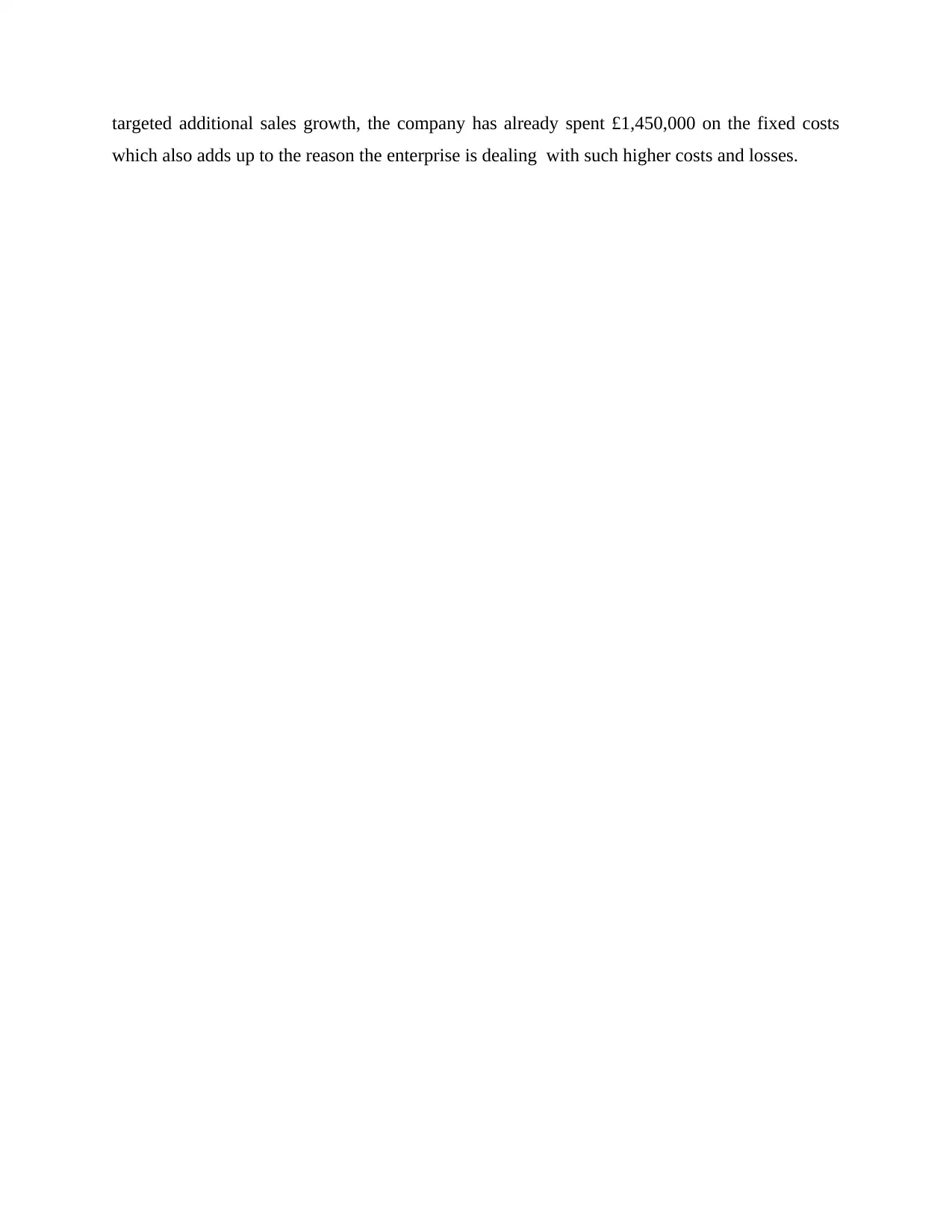
targeted additional sales growth, the company has already spent £1,450,000 on the fixed costs
which also adds up to the reason the enterprise is dealing with such higher costs and losses.
which also adds up to the reason the enterprise is dealing with such higher costs and losses.
⊘ This is a preview!⊘
Do you want full access?
Subscribe today to unlock all pages.

Trusted by 1+ million students worldwide
1 out of 19
Related Documents
Your All-in-One AI-Powered Toolkit for Academic Success.
+13062052269
info@desklib.com
Available 24*7 on WhatsApp / Email
![[object Object]](/_next/static/media/star-bottom.7253800d.svg)
Unlock your academic potential
Copyright © 2020–2025 A2Z Services. All Rights Reserved. Developed and managed by ZUCOL.




